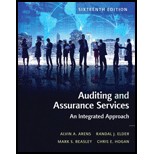
Auditing and Assurance Services (16th Edition)
16th Edition
ISBN: 9780134065823
Author: Alvin A. Arens, Randal J. Elder, Mark S. Beasley, Chris E. Hogan
Publisher: PEARSON
expand_more
expand_more
format_list_bulleted
Question
Chapter 8, Problem 27.2MCQ
To determine
Identify the option that is expected to detect misstatements that aggregate.
Expert Solution & Answer
Want to see the full answer?
Check out a sample textbook solution
Students have asked these similar questions
General accounting
Your firm has net income of $420 on total sales of
$1,600. Costs are $900, and depreciation is $150. The
tax rate is 28%. The firm does not have interest
expenses.
What is the operating cash flow (OCF)?
A) $570
B) $560
C) $420
D) $600
At the end of the year, Tech Solutions Inc. reported total
assets of $200,000 and total liabilities of $85,000. What
is the total equity for Tech Solutions Inc. at year-end?
A) $285,000
B) $115,000
C) $85,000
D) $200,000
Chapter 8 Solutions
Auditing and Assurance Services (16th Edition)
Ch. 8 - Prob. 1RQCh. 8 - Prob. 2RQCh. 8 - Prob. 3RQCh. 8 - Prob. 4RQCh. 8 - Prob. 5RQCh. 8 - Prob. 6RQCh. 8 - Prob. 7RQCh. 8 - Prob. 8RQCh. 8 - Prob. 9RQCh. 8 - Prob. 10RQ
Ch. 8 - Prob. 11RQCh. 8 - Prob. 12RQCh. 8 - Prob. 13RQCh. 8 - Prob. 14RQCh. 8 - Prob. 15RQCh. 8 - Your client, Harper Company, has a contractual...Ch. 8 - Prob. 17RQCh. 8 - Prob. 18RQCh. 8 - Prob. 19RQCh. 8 - Prob. 20RQCh. 8 - Prob. 21RQCh. 8 - Prob. 22RQCh. 8 - Prob. 23RQCh. 8 - Prob. 24RQCh. 8 - Prob. 25.1MCQCh. 8 - Prob. 25.2MCQCh. 8 - Prob. 25.3MCQCh. 8 - Prob. 26.1MCQCh. 8 - Prob. 26.2MCQCh. 8 - Prob. 26.3MCQCh. 8 - Which one of the following statements is correct...Ch. 8 - Prob. 27.2MCQCh. 8 - Prob. 27.3MCQCh. 8 - Prob. 28.1MCQCh. 8 - Prob. 28.2MCQCh. 8 - Prob. 28.3MCQCh. 8 - Prob. 29DQPCh. 8 - Prob. 30DQPCh. 8 - Prob. 31DQPCh. 8 - Your comparison of the gross margin percent for...Ch. 8 - Prob. 33DQPCh. 8 - Prob. 34DQPCh. 8 - Prob. 35DQPCh. 8 - Prob. 36DQPCh. 8 - Prob. 37DQPCh. 8 - Following are statements of earnings and financial...
Knowledge Booster
Similar questions
- Financial accounting questionarrow_forwardBrightClean Car Wash reviewed its water bill and found that the highest bill was $5,000 when they washed 500 cars, and the lowest bill was $3,200 when they washed 300 cars. What is the variable cost per car associated with the water bill? A) $8.00 B) $9.00 C) $7.50 D) $8.50arrow_forwardwhat was the stockholders' equity at year-end? accounting questionarrow_forward
- what was the stockholders' equity at year-endarrow_forwardGeneral Account tutor please find solutionarrow_forwardHamilton Textiles has the following data: • Beginning raw materials inventory = $90,000 Materials purchased = $55,000 Ending raw materials inventory = $75,000 Calculate the cost of raw materials used.arrow_forward
arrow_back_ios
SEE MORE QUESTIONS
arrow_forward_ios
Recommended textbooks for you
 Auditing: A Risk Based-Approach to Conducting a Q...AccountingISBN:9781305080577Author:Karla M Johnstone, Audrey A. Gramling, Larry E. RittenbergPublisher:South-Western College Pub
Auditing: A Risk Based-Approach to Conducting a Q...AccountingISBN:9781305080577Author:Karla M Johnstone, Audrey A. Gramling, Larry E. RittenbergPublisher:South-Western College Pub Auditing: A Risk Based-Approach (MindTap Course L...AccountingISBN:9781337619455Author:Karla M Johnstone, Audrey A. Gramling, Larry E. RittenbergPublisher:Cengage Learning
Auditing: A Risk Based-Approach (MindTap Course L...AccountingISBN:9781337619455Author:Karla M Johnstone, Audrey A. Gramling, Larry E. RittenbergPublisher:Cengage Learning

Auditing: A Risk Based-Approach to Conducting a Q...
Accounting
ISBN:9781305080577
Author:Karla M Johnstone, Audrey A. Gramling, Larry E. Rittenberg
Publisher:South-Western College Pub

Auditing: A Risk Based-Approach (MindTap Course L...
Accounting
ISBN:9781337619455
Author:Karla M Johnstone, Audrey A. Gramling, Larry E. Rittenberg
Publisher:Cengage Learning
